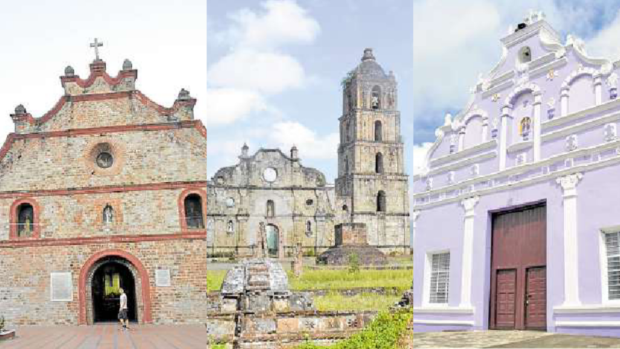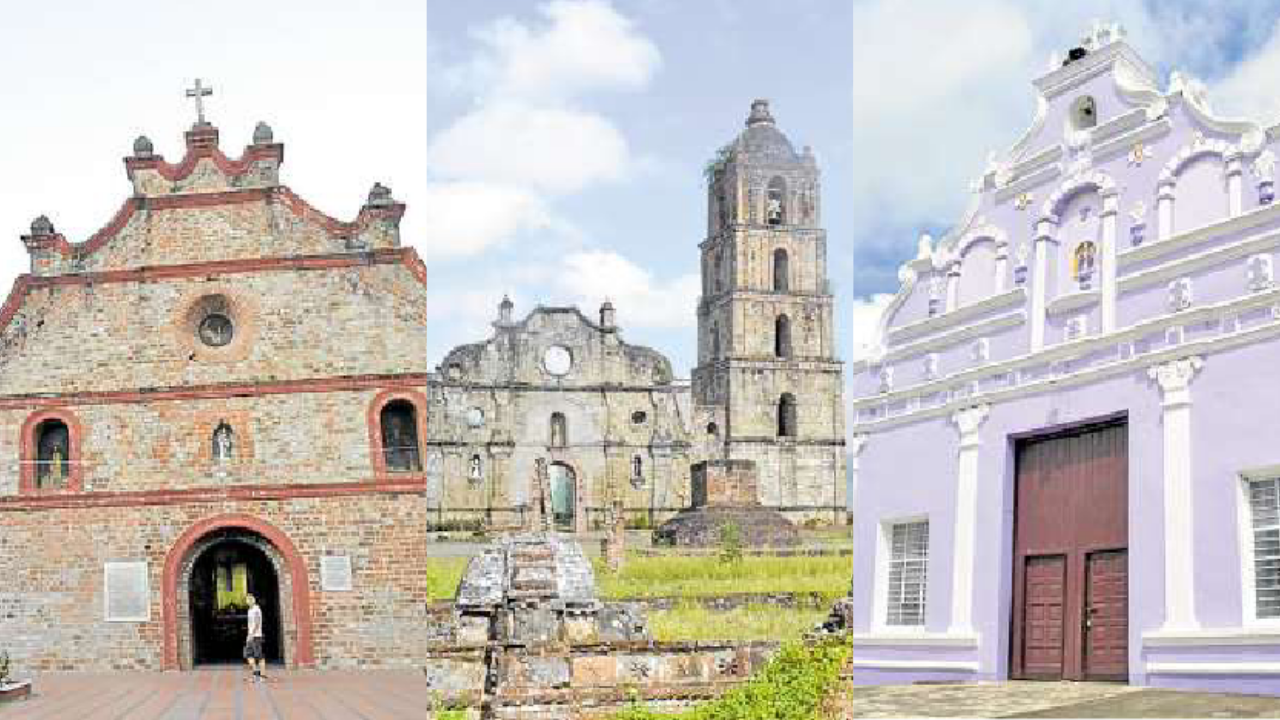
A national cultural treasure (NCT) is defined under the National Cultural Heritage Act of 2009 as “a unique cultural property found locally, possessing outstanding historical, cultural, artistic and/or scientific value which is highly significant and important to the country and nation, and officially declared as such by the pertinent cultural agency.”
Meanwhile, the same law defines important cultural property (ICP) as “a cultural property having exceptional cultural, artistic and historical significance to the Philippines, as shall be determined by the National Museum and/or National Historical Institute.”
Every year, the National Museum of the Philippines (NMP) declares NCTs and ICPs, but has not released the lists en masse in recent years as it became more careful, getting the approval of the stakeholders first before officially declaring a site or structure as such.
This task of declaring sites and structures was transferred under the authority of the National Commission for Culture and the Arts in 2021 following the passage of the National Museum of the Philippines Act in 2019, which gave the NMP exclusive museum function.
First time
Lifestyle obtained a document from Ivan Henares of The International Committee for the Conservation of Industrial Heritage-Philippines on the sites and structures declared by the NMP from 2018 to 2020, a list not released to the public. Here is the complete list; these declarations are mostly sites that date back to the Spanish colonial period.
It notably includes four new sites declared as NCTs: Cavite City, Panciteria Macanista de Buen Gusto, the Narvacan-Santa viaduct and Apalit Church.
Declared NCTs in 2018 were Nuestra Señora de las Angustias Chapel, the San Diego de Alcala Chapel ruins, Cementerio de los Españoles and Santuario de las Almas, and Cementerio de los Indios and its mortuary chapel, all in Tayabas, Quezon; the Narvacan-Santa viaduct in Ilocos Sur; the Philippine Normal University buildings (Geronima T. Pecson Hall, or Main Building; Normal Hall; and the former Training Department Building); and the Far Eastern University (FEU) buildings and immovable cultural properties, which include Nicanor Reyes Hall, or the Main Building, Engineering Building, Law Building and Science Building all designed by National Artist Pablo Antonio Sr., the Felipe Mendoza-designed chapel, including the Fatima mosaic on its facade, designed by Vicente Manansala, the “Crucifixion of Christ” and “Via Crucis” paintings by Botong Francisco, and the stained glass panels by Antonio Dumlao.
Also declared NCTs were the bronze sculptures by Manansala at FEU Quadrangle and Francesco Monti’s bas reliefs at the lobby of the Administration Building.
Those declared NCTs the following year were the concrete and bronze Oblation sculptures at the University of the Philippines (UP) Diliman by Guillermo Tolentino; Quezon Memorial Shrine by Federico Ilustre and “its intrinsic settings” in Quezon City; Quezon Institute Complex by Juan Nakpil, also in Quezon City; Leandro Locsin’s Cultural Center of the Philippines Main Building, including the Manansala bas relief titled “The Seven Arts,” the Hernando Ocampo piece “Woven Curtain” at the Main Theater stage, the triptych painting by Arturo Luz at the foyer of Tanghalang Aurelio Tolentino and the Roberto Chabet woven curtain at the Little Theater stage; Philippine International Convention Center, also by Locsin and the works of art inside and outside the building, which include Luz’s sculptures “Anito” and “Grid,” a well as Jose Joya’s “Ang Pagdiriwang” painting, and a piece of wooden furniture by Napoleon Abueva; Apalit Church complex and the ruins of Tabuyuc Chapel in Apalit and the church of San Luis in Pampanga; San Pablo de Cabagan Church Complex and Casa Real ruins in San Pablo, Isabela; the church complexes of Carcar, Sibonga, Argao, Dalaguete and Oslob in Cebu; the Pavillion of Magellan’s Cross, the Santo Niño Basilica complex, Fort San Pedro, Plaza Independencia, and Cebu Customs House in Cebu City; the Palawan fortifications and their settings in the towns of Taytay, Dumaran, Culion, Linapacan, Agutaya, Cuyo, Cagayancillo, and Balabac; Guadalupe Fort in San Jose, Antique, including its setting; Dapitan Church, old Dapitan Municipal Hall and Dapitan Plaza in Zamboanga del Norte; and Taal’s Caysasay Church Complex including Sta. Lucia Well, Hagdan-Hagdan and their settings.
Cavite peninsula
In 2019, the NMP declared the entire Cavite peninsula, where the fortified town of Cavite Puerto (now Cavite City) is located, as an NCT.
Included in this declaration was the old causeway, now M. Valentino Street to Ramon Samonte Park to Naval Station, the Sta. Monica Church belfry, main gate and western portion of Fort San Felipe, and “the sites, vestiges and archaeological remains of its Spanish colonial era fortifications, military buildings and installations, shipyards, public monuments, public buildings, churches and religious buildings, houses and private establishments, streets and other infrastructure, together with associated anchorages and underwater sites in Bacoor and Cañacao Bay, and its intrinsic natural setting overall relative to the surrounding water.”
Severino Laberto Building, or Panciteria Macanista de Buen Gusto in Binondo, mentioned in Jose Rizal’s novel “El Filibusterismo,” led the declarations in 2020.
Apart from the Buen Gusto building, other declarations that year included the Budiao Church ruins in Daraga, Albay; Agoo watchtower in La Union; Calape and Anda churches in Bohol; Quezon watchtowers in Atimonan, Gumaca, Macalelon, Pitogo and Unisan; watchtowers of Punta Portuguesa in Sual, Pangasinan and in Gabu Sur, Laoag, Ilocos Norte; the archaeological sites of Ayub Cave in Maitum in Sarangani, New Ibajay in El Nido in Palawan and Kamhantik in Mulanay in Quezon; Shell Midden Site in Lal-lo and Gattaran in Cagayan; Taytay Boni in Miag-ao in Iloilo, Spanish-era bridge in Sta. Maria in Ilocos Sur and Paoay Bridge in Ilocos Norte; and the Church Complex of San Vicente including Escuela, Municipio and Asilo de San Vicente in Ilocos Sur.
Important cultural properties
For the ICP category, the NMP declared in 2018 San Lorenzo Martyr Church Complex, the Tigbi old Escuela building, Nuestra Señora de Salvacion Church Complex and the Simbahanan church ruins in Tiwi, Albay; Marikina Church, including Jesus de la Peña Chapel, Shoe Museum, and the Kapitan Moy, Chanyungco and Zamora heritage houses; the vitu wells of Batan and Sabtang in Batanes; Karaang Jasaan archeological site in Misamis Oriental; church complexes of Malate, Manila and Duero, Bohol; Sabang Bridge between Ibaan and Batangas City; Spanish-era bridge in Sampaloc, Quezon; Philippine General Hospital buildings (Central Administration, Ward Pavilions, Dispensary, Nurses’ Home); the Philippine School for the Deaf main building in Pasay; Jesuit Mirador Hill Complex including Lourdes Grotto in Baguio City; Manila’s St. Paul University Chapel and Fleur-de-lis Theater; Santa Isabel College Chapel and Administration Building in Manila; Adamson University buildings (St. Vincent Building, St. Theresa Building, St. Vincent de Paul Church); Letran buildings in Intramuros (St. John the Baptist Building, St. Raymond of Peñafort Building, St. Dominic de Guzman Building, site and archaeological remains of the old Dominican convent); Pasig’s Bahay na Tisa; St. Scholastica’s College buildings (St. Cecilia’s Hall, Chapel, St. Scholastica Building, St. Hildegarde Building); Redemptorist Church in Baclaran; Abbey of Our Lady of Montserrat inside San Beda University in Manila; and St. La Salle Hall of De La Salle University Manila.
Old buildings
Meanwhile, Guillermo Tolentino’s Manuel Quezon and Sergio Osmeña statues at Old Legislative Building were declared ICPs in 2019, together with Jose Alcantara’s Philam Life sculptures and Manansala’s Philam Life paintings; Francisco Mañosa’s Edsa Shrine; Pablo Antonio’s Bel Air Apartments and Jose Maria Zaragoza’s Pope Pius XII Catholic Center in Manila, plus his Meralco Building in Pasig and Commercial Bank and Trust Company Building on Escolta; Locsin’s Makati Stock Exchange Building and the old Nielsen Airport Passenger Terminal and Control Tower in Makati; the statues of Carlos P. Garcia and Sandugo in Tagbilaran; Juan Arellano’s Bank of the Philippine Islands-Cebu in Cebu City as well as Casa Gorordo, Jesuit House, the Yap-San Diego house; Cebu’s old Provincial Hall (now Museo Sugbu), Fuente Osmeña, Gotiaco Building (the old Compaña Maritima Building), and the San Vitalis y La Immaculada Concepcion church complex; Tagbilaran’s heritage houses (Rocha House, Rocha-Suarez House, Rocha-Hontañosa House, Yap House, Belda House); Plaza Rizal, Escuela de Niñas, Escuela de Niños site, San Jose Obrero church complex, all in Tagbilaran; Old Balilihan Municipio in Bohol; Rizal; UP Diliman buildings designed by Juan Nakpil (Quezon Hall, Gonzalez Hall, Carillon Tower); Coconut Palace by Mañosa; Ninoy Aquino International Airport Terminal 1 by Locsin; Federico Ilustre’s old GSIS Building, Quirino Grandstand and National Planetarium in Manila; San Fernando Bridge, also known as Puente de General Blanco in Binondo; Manila City Hall and the nearby National Waterworks and Sewerage Authority Building; Old Department of Agriculture and Commerce and Old Department of Finance buildings at Rizal Park, now part of the NMP Complex; Makati’s old Presidencia, the San Pedro Macati church, Guadalupe Church and San Nicolas Ermita; Locsin’s National Arts Center in Los Baños; Isabel II Monument in Arevalo, Iloilo, including its setting; Tigbauan Church facade in Iloilo; Antique old Provincial Capitol in San Jose de Buenavista; the Isabela church complexes in the towns of Gamu, Cauayan and Alicia; Nueva Vizcaya’s cathedral complex of Santo Domingo in Bayombong, Bambang church complex, and the Bagabag belfry; old Taal church ruins in what is now San Nicolas, Batangas; Puerto Princesa cathedral and the nearby Cuarteles ruins and Plaza Rizal; archeological sites and petrographs of Anda in Bohol; and the archeological site of a kiln built during the Spanish period in Alubijid, Misamis Occidental.
Heritage dams
The American-period Wawa Dam and its setting in Montalban, Rizal, was also declared an ICP together with the Spanish-era Ligas Dam between Las Piñas City and Bacoor, Cavite. The last one is referred to today as Molino Dam, but there are many “Molino” dams in Bacoor. These last two mentioned are the first such recognition for heritage dams in the country, the topic of specialization of this writer.
In 2020, the NMP declared as ICPs the Balili House and the old building of Holy Spirit School in Tagbilaran; Bahay na Tisa in Bacoor, Cavite; China Bank Building in Binondo; lighthouses on Balicasag Island in Panglao and in Loon, Bohol; Kerr and Co. Building, Ynchausti y Compañia Building (now Museum of Philippine Economic History), Customs House on Muelle Loney and Casa Real with Arroyo Fountain, all in Iloilo City; leguarios of Spanish-era milestones in Ilocos Norte (Pasuquin and Laoag) and Tayum, Abra; the churches of Bohol (Tubigon, Talibon, Jagna, Guindulman, Carmen, Balilihan); Binondo Church; Currimao Port Complex in Ilocos Norte which includes the Port Master’s house, wharf and tobacco warehouse; Bacoor Church in Cavite; and Dumaguete’s watchtower-belfry. —CONTRIBUTED









































